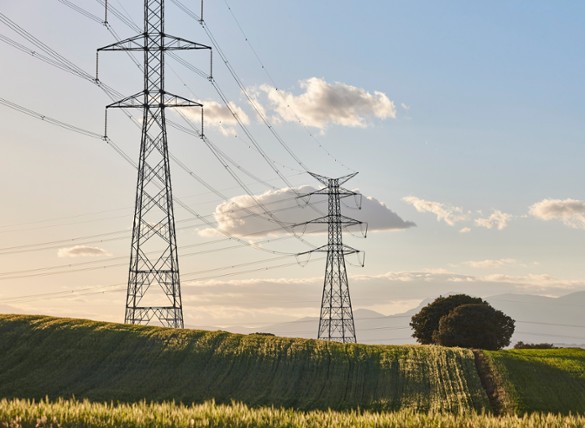Data Centre Tailwinds Drive Steady Infrastructure Gains
Q3 2025 Global Infrastructure Income Strategy Commentary
Key Takeaways
- Listed infrastructure delivered positive returns in the third quarter, trailing global equities as animal spirits drove a risk-on market.
- U.S. utilities, renewables and North American natural gas and pipelines performed well, benefiting from elevated demand for power to support AI-focused data centres.
- We continue to see strong opportunities driven by decarbonisation and the energy transition in electric utilities in the U.S., the EU and the U.K., where we’re seeing a major buildout of renewables, poles and wires to be able to move energy around the grid.
Market Overview
Listed infrastructure delivered positive returns in the third quarter, trailing global equities as animal spirits drove a risk-on market.
Strength in infrastructure was broad based. U.S. utilities, renewables and North American natural gas and pipelines performed well, benefiting from elevated demand for power to support AI-focused data centres. Other tailwinds for this group included resilient end markets in Europe for renewables as well as high utilisation of pipeline assets and continued momentum in project origination for Canadian pipelines. Meanwhile, European utilities were lower, weighed down by U.K. water utilities, which were weaker due to higher interest rates.
On the GDP-sensitive side, North American rails performed well on news of a proposed merger in the space that could unlock significant value. Solid operating trends and the broader market rally driven by trade negotiations and de-escalations in U.S. trade policy helped Western airports.
Toll roads were down due to some political uncertainty, particularly in France, with the rise in sovereign risk resulting from the French budget fallout and the failed vote of confidence on the Prime Minister, who has since been replaced. The bottom performer was communication towers, which are seeing a slower pace of growth in carrier capex in the current 5G cycle and where investors are awaiting positive catalysts in the fourth quarter.
On a regional basis, the U.S. and Canada region was the top contributor for the quarter, with U.S. electric utility Entergy and Canadian gas company TC Energy the lead performers. Entergy is a pure regulated electric utility, providing services to approximately three million people in Arkansas, Louisiana, Texas and Mississippi. Entergy’s share price rallied during the quarter with continued momentum on the company signing data centre deals.
TC Energy (TC) is a North American company managing over 93,300 km of natural gas pipelines and 4.3 GW of power assets. Nearly 100% of TC’s cash flows are backed by stable long-term contracts and cost-of-service tolling with creditworthy counterparties. TC continued to benefit from the current favorable environment for project origination, as the strong demand for energy infrastructure drove accretive expansions along the network.
Spanish electric utility Redeia and French toll road operator Vinci were the largest detractors.
Redeia is engaged in the supply and transmission of electricity and is the sole high-voltage transmission agent and system operator in Spain. Redeia’s share price was negatively impacted by the recent draft proposal from its Spanish regulator, which pointed to a lackluster remuneration framework for the 2026–2031 regulatory period.
Vinci operates half of France’s toll road network under long-term concession agreements, with a growing portfolio of airport concessions and a global contracting business. Shares were negatively impacted by political uncertainty in France following the vote of confidence on the Prime Minister and his proposed budget. We view these developments as not having any tangible impact on Vinci’s toll road operations in France, which continue to perform in line with expectations.
Outlook
Looking ahead, we continue to see strong opportunities driven by decarbonisation and the energy transition, for example in electric utilities in the U.S., the EU and the U.K., where we’re seeing a major buildout of renewables, poles and wires to be able to move energy around the grid.
U.S. and EU electric and water utilities are also investing in their networks to improve the resiliency of the grid to adapt to or mitigate the effects of climate change. Reshoring is also driving investments to handle increased load growth. And of course, AI-focused data centres are also requiring significant buildout of energy infrastructure, in particular for U.S. electric and gas utilities.
With these tailwinds, we are constructive on our infrastructure portfolios, which balance these strengths with more GDP-sensitive sectors such as airports, toll roads and rails benefiting from a resilient global economy.
Portfolio Highlights
We believe an absolute return, inflation-linked benchmark is the most appropriate primary measure against which to evaluate the long-term performance of our infrastructure strategies. The approach ensures the focus of portfolio construction remains on delivering consistent absolute real returns over the long term.
On an absolute basis, the Strategy saw positive contributions from five of 10 sectors in which it was invested in the quarter, with electric and gas utilities the top contributors and water and toll roads the main detractors.
Relative to the FTSE Global Core Infrastructure 50/50, the Strategy underperformed in the third quarter, driven primarily by stock selection in the electric utility, water utility and toll roads sectors. Stock selection in the energy infrastructure and gas utility sectors and an underweight to communications proved beneficial.
On an individual stock basis, the top contributors to absolute returns in the quarter were Entergy, TC Energy, Enbridge, NextEra Energy and South Bow. The main detractors were Vinci, Redeia, Severn Trent, Canadian National Railway and ONEOK.
During the quarter, we initiated positions in Italian airport operator ENAV, which provides air traffic control and management, and other air navigation services in Italy, the rest of Europe and internationally. and Spanish electric utility Iberdrola, a high-quality, large-cap utility benefiting from improving Spanish regulation. We also exited our positions in Brazilian electric utility Eletrobras, Canadian energy infrastructure company Pembina Pipeline and Portuguese renewables company Energias de Portugal.
Related Perspectives

Infrastructure Outlook: AI, Decarbonisation and Policy Tailwinds in 2026
Structural tailwinds like decarbonisation, network upgrades and climate-proofing, along with AI’s need for power, are fuelling long-term capital expenditure cycles for infrastructure.
Read full article


